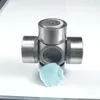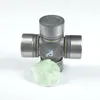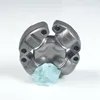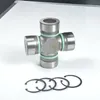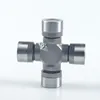A universal joint, often referred to as a U-joint, is a mechanical device used to connect two rotating shafts at an angle, allowing the transmission of torque and rotation. It is commonly employed in various applications, including automotive drive systems, industrial machinery, and aerospace equipment. The flexibility of a universal joint accommodates misalignment between shafts, ensuring smooth and efficient power transfer even when the shafts are not perfectly aligned.
| Parameter | Description | Value Range |
|---|---|---|
| Material | Typically made from alloy steel, stainless steel, or thermoplastic composites | Varies by model |
| Bore Diameter | Inner diameter for shaft connection | 10 mm to 100 mm |
| Maximum Torque Capacity | Peak torque handling without failure | 50 Nm to 2000 Nm |
| Operating Angle | Maximum permissible angle between shafts | 0° to 45° |
| Speed Rating | Maximum RPM for safe operation | Up to 5000 RPM |
| Weight | Varies based on size and material | 0.5 kg to 15 kg |
| Temperature Range | Operational limits in Celsius | -40°C to 120°C |
Universal joints are versatile components used across multiple industries. In automotive systems, they are essential for drive shafts, steering columns, and propeller shafts. Industrial applications include conveyor systems, pumps, and robotic arms. The aerospace sector relies on them for control mechanisms and engine linkages. Their ability to handle misalignment and transmit torque efficiently makes them ideal for dynamic and high-load environments.
What is the primary function of a universal joint?
The primary function is to transmit rotational motion and torque between shafts that are not aligned, allowing for angular misalignment while maintaining constant velocity in certain designs.
How do I choose the right universal joint for my application?
Consider factors such as torque requirements, operating angle, speed, environmental conditions (e.g., temperature and corrosion resistance), and material compatibility. Always refer to manufacturer specifications and consult engineering guidelines for optimal selection.
Can universal joints handle high-speed operations?
Yes, but the maximum speed depends on the joint's design and balance. High-speed universal joints are precision-balanced to minimize vibrations and are rated for specific RPM ranges. Exceeding these limits can lead to failure.
What maintenance is required for universal joints?
Maintenance varies by type; some are sealed and lubricated for life, while others require periodic greasing. Regular inspections for wear, noise, or play are recommended to ensure longevity and prevent downtime.
Are there different types of universal joints?
Yes, common types include single universal joints, double universal joints, constant velocity (CV) joints, and needle bearing joints. Each type has specific advantages for different applications, such as reducing vibrations or handling greater angles.
What materials are used in universal joint construction?
Materials range from alloy steel for high-strength applications to stainless steel for corrosion resistance, and thermoplastics for lightweight, low-cost uses. The choice depends on load, environment, and budget.
How do I install a universal joint properly?
Ensure shafts are clean and aligned within tolerances. Use appropriate fasteners and follow torque specifications. For balanced joints, maintain orientation as per markings to avoid vibrations. Always refer to the installation manual.
What are the signs of a failing universal joint?
Common signs include clunking noises during acceleration or deceleration, vibrations at certain speeds, visible wear or rust on bearings, and excessive play when manually moving the joint. Prompt replacement is advised to avoid further damage.
Can universal joints be used in underwater applications?
Yes, with proper sealing and corrosion-resistant materials like stainless steel or coated alloys. Special waterproof universal joints are available for marine and submersible equipment, but regular maintenance is crucial.
What is the difference between a universal joint and a constant velocity joint?
A universal joint can cause velocity fluctuations at certain angles, leading to vibrations, whereas a constant velocity joint maintains uniform speed output regardless of angle, making it smoother for applications like automotive axles.

